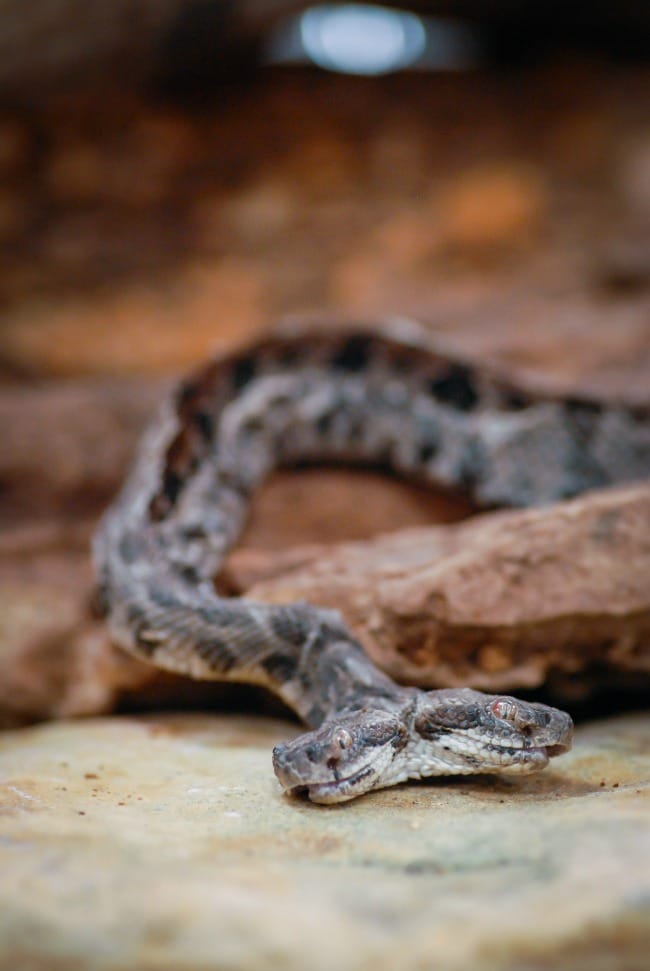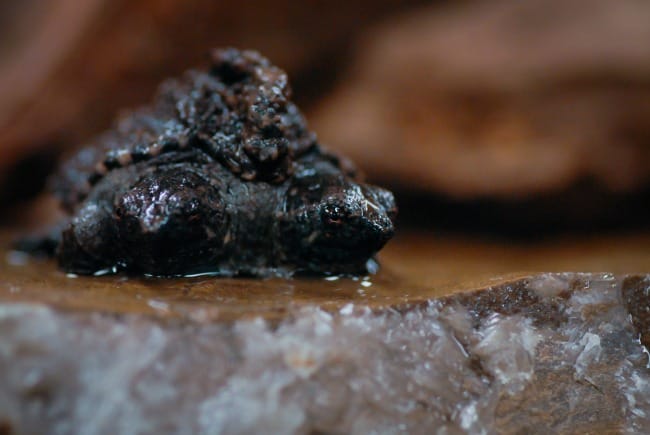

Uh oh...
It appears that you're using a severely outdated version of Safari on Windows. Many features won't work correctly, and functionality can't be guaranteed. Please try viewing this website in Edge, Mozilla, Chrome, or another modern browser. Sorry for any inconvenience this may have caused!
Read More about this safari issue.

If you spend any time in the Arkansas outdoors you are likely to come across a snake or two. In most cases snakes will leave you alone if you leave them alone. Even still, when I spot a snake I always get a fright. Now imagine if that snake had two heads!
Rodney Kelso, a worker for Woodruff County Electric, was on the job in Forrest City this September when he spotted several venomous snakes. Upon closer inspection he discovered two normal Timber Rattlers and one that appeared to have two heads. Kelso was able to maneuver the snake into a box and decided to take it to the Forrest L. Wood Crowley’s Ridge Nature Center in Jonesboro.
Timber Rattlers are Arkansas’s most venomous snake and adults can grow longer than four feet. The two-headed snake was only about 11-inches long indicating that it was a fairly young snake, perhaps only a few weeks old.

Shaun Merrell, Facilities Director at Forrest L. Wood Crowley’s Ridge Nature Center, said that the center didn’t feel that they were properly equipped to care for the snake and it was transferred to the Biology department at Arkansas State University in Jonesboro shortly after its arrival. Dr. Lori Neuman-Lee, assistant professor of Biology at ASU, was one of the primary caregivers of the snake which had been nicknamed “Deuce” during its stay at the nature center.
When I spoke with Dr. Neuman-Lee you could hear the excitement in her voice over the discovery of the unique creature along with great sadness when she revealed that the snake recently died. A two-headed snake is rare although most herpetologists have dealt with a two-headed snake at some point in their career. A snake in this condition has a variety of things working against it and most do not live very long. In fact, most die so early in nature that there is very little accurate documentation about how often something like this occurs.
A snake can be born with two heads due to some sort of genetic mutation or an “incomplete twinning” situation. Similar to what happens with human conjoined twins, some body parts are duplicated as the egg divides but complete separation into two eggs never occurs.

Since two-headed snakes are rare, Dr. Neuman-Lee consulted with several people who regularly work with similar reptiles. The fact that this was also a venomous reptile made the situation even more precarious. “Deuce” was slow moving and sometimes needed assistance moving in and out of water. He did consume several small meals and was regularly drinking. However, handling a snake like this can cause it a lot of stress so everything had to be done very carefully.
The snake passed one night which saddened Dr. Neuman-Lee and the staff in the Biology department. Since he had been eating they were disappointed but not entirely surprised. Life for animals like this can be very difficult and stressful. Fortunately, the snake continued to offer insight, even in death. A necropsy was performed and filmed for educational purposes. In addition to its two functional heads the snake also had two hearts, two thyroid glands, two lungs (most snakes only have one) and 2 stomachs. The snake only had one shared spleen and pancreas and only two kidneys. Although there was no obvious cause of its death, Dr. Neuman-Lee feels confident that only having two kidneys are likely what lead to its death. The kidneys filter out waste and two were likely not enough to keep the snake healthy.
About the same time that the snake arrived at ASU a two-headed snapping turtle was also brought in. The snapping turtle was hatched from a local farm.

Since it can be unclear what the internal functions of a two-headed reptile are, they are treated as two creatures and each head must be fed separately to make sure it stays properly nourished. This can cause some problems as is the case with the snapping turtle. There has been some concern about the two heads fighting each other over food. Fortunately, those working with the turtle have prevented any problems so far. The turtle does have some coordination issues and there were some initial concerns that it would drown but it appears to be figuring things out.
Dr. Neuman-Lee and others at ASU continue to study and learn from the turtle. The department is working on preservation of the snake so that he can be eventually put on display and future students can continue to study this unique reptile.
Photos provided by Dr. Neuman-Lee and the ASU Biology Department.
We do the work.
You check your email.
Sign up for our weekly e-news.
Get stories sent straight to your inbox!







Like this story? Read more from Julie Kohl
We live in a time when many Arkansans are returning to their...
July in Arkansas means loads of sunshine and sweltering hot days. It's a...
There’s something wonderfully freeing about waking up and deciding,...
Join the Conversation
Leave a Comment